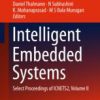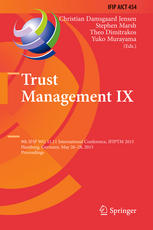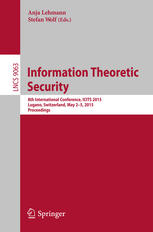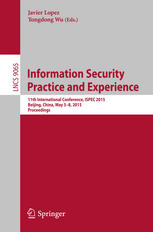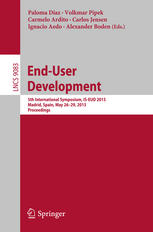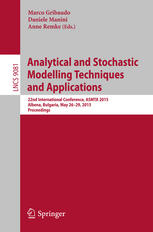Codes Cryptology and Information Security First International Conference C2SI 2015 Rabat Morocco May 26 28 2015 Proceedings In Honor of Thierry Berger 1st Edition by Said El Hajji, Abderrahmane Nitaj, Claude Carlet, El Mamoun Souidi 3319186818 9783319186818
$50.00 Original price was: $50.00.$25.00Current price is: $25.00.
Codes Cryptology and Information Security First International Conference C2SI 2015 Rabat Morocco May 26 28 2015 Proceedings In Honor of Thierry Berger 1st Edition by Said El Hajji, Abderrahmane Nitaj, Claude Carlet, El Mamoun Souidi – Ebook PDF Instant Download/DeliveryISBN: 3319186818, 9783319186818
Full download Codes Cryptology and Information Security First International Conference C2SI 2015 Rabat Morocco May 26 28 2015 Proceedings In Honor of Thierry Berger 1st Edition after payment.
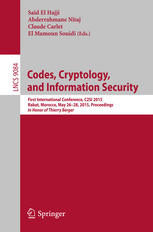
Product details:
ISBN-10 : 3319186818
ISBN-13 : 9783319186818
Author: Said El Hajji, Abderrahmane Nitaj, Claude Carlet, El Mamoun Souidi
This book constitutes the proceedings of the First International Conference on Codes, Cryptology and Information Security, C2SI 2015, held in Rabat, Morocco, in May 2015. The 22 regular papers presented together with 8 invited talks were carefully reviewed and selected from 59 submissions. The first aim of this conference is to pay homage to Thierry Berger for his valuable contribution in teaching and disseminating knowledge in coding theory and cryptography in Morocco since 2003. The second aim of the conference is to provide an international forum for researchers from academia and practitioners from industry from all over the world for discussion of all forms of cryptology, coding theory and information security.
Codes Cryptology and Information Security First International Conference C2SI 2015 Rabat Morocco May 26 28 2015 Proceedings In Honor of Thierry Berger 1st Table of contents:
1 Local Realism and CHSH Inequalities
1.1 Local Realism
1.2 CHSH Inequalities
1.3 Quantum World
1.4 Complete Set of Inequalities
1.5 Generalization to
2 Multidimensional Inequalities
2.1 Discrete Fourier Transform
2.2 Homogeneous Inequalities
3 Violation by Quantum Systems
3.1 Measurements with Tritters
4 Quantum Keys Exchange
4.1 Ekert’91 Protocol
4.2 The Inequality CHSH-3
4.3 The 3DEB Protocol
4.4 The Homogeneous Qutrits Protocol
5 Conclusion
References
Securing the Web of Things with Role-Based Access Control
1 Introduction
2 Overview of WoT
2.1 Representation of Things on WoT
2.2 Ambient Space Stakeholders
2.3 WoT Framework
2.4 WoT Security Challenges
3 Overview of Role Based Access Control (RBAC) Model
4 Security Architecture for WoT
4.1 Integrating RBAC in WoT
4.2 Policy Enforcement Facitilies
4.3 Areas of Control Architecture
5 WOT Resources Protection
5.1 Documents and Views
5.2 Key Generation and Encryption
6 Conclusion and Future Work
References
On the Security of Long-Lived Archiving Systems Based on the Evidence Record Syntax
1 Introduction
2 ERS Archiving System
2.1 Setup
2.2 ERS Specification
3 Security Framework
3.1 Task-PIOAs
3.2 Longterm Implementation Relation
3.3 CIS System Model
4 ERS System Model
4.1 Construction Overview
4.2 Signature Service
4.3 Timestamp Service
4.4 Hash Service
4.5 Service Times
4.6 Dispatcher
4.7 ERS Service
5 ERSSecurityProof
6 Conclusions
References
Differential Attacks Against SPN: A Thorough Analysis
1 Introduction
2 Differential Attacks Against Substitution-Permutation Networks
2.1 Substitution-Permutation Networks
2.2 Differential Cryptanalysis
2.3 Expected Probability of a Differential Characteristic
3 From Characteristics to Differentials
3.1 Expected Probability of a 2-round Differential
3.2 Influence of the Weight of the Differential
3.3 Number of Characteristics Within a Given 2-round Differential
4 SPNwithanAPNSbox
4.1 APN Sboxes over F8
4.2 APN Sboxes over F32
5 MEDP2 can be Tight for a Differential of Non-minimal Weight
5.1 Examples where MEDP2 is Tight for a Differential of Weight (
5.2 Example where MEDP2 is Tight for a Differential of Weight (
6 Conclusions
References
On the Properties of Vectorial Functions with Plateaued Components and Their Consequences on APN Fun
1 Introduction
2 Preliminaries
3 Characterizations of Plateaued Boolean and Vectorial Functions
3.1 Characterization by Means of the Derivatives
3.2 Characterization by Means of Power Moments of the Walsh Transform
4 Characterizations of the APN-ness of Componentwise Plateaued Vectorial Functions
4.1 Characterization by the Derivatives
4.2 Characterization by the Walsh Transform
4.3 The Case of Unbalanced Component Functions
References
Beyond Cryptanalysis Is Software Security the Next Threat for Smart Cards
1 Introduction
2 Smart Card Security
3 Some Software Attacks Again Java Card
3.1 Ambiguity in the Specification: The Type Confusion
3.2 Weakness in the Linker Process
3.3 Dumping the EEPROM
3.4 Dumping the ROM
3.5 A Complete Methodology to Attack Smart Card
4 Conclusion and Future Works
References
Extended Abstract: Codes as Modules over Skew Polynomial Rings
References
Regular Papers
CUBE Cipher: A Family of Quasi-Involutive Block Ciphers Easy to Mask
Introduction
1 Specifications
1.1 Key Schedule
1.2 Instantiations
2 Design Rationale
3 Security Analysis
4 Implementation Aspects
4.1 Theoretical Implementation Results
4.2 Implementation Results and Comparisons
5 Conclusion
References
A Dynamic Attribute-Based Authentication Scheme
1 Introduction
2 ABA Scheme Introduction
2.1 Scheme Structure and Workflow
2.2 Security Requirements
3 Construction of the Dynamic ABA Scheme
3.1 Down-to-Top Attribute Tree Construction
3.2 Construction Algorithms
4 Analysis of the Dynamic ABA Scheme
4.1 Correctness Analysis
4.2 Security Requirements Analysis
4.3 Efficiency Analysis
5 Conclusions
References
Repeated-Root Isodual Cyclic Codes over Finite Fields
1 Introduction
2 Preliminaries
3 Cyclic Codes of Length 2amps over
4 Construction of Cyclic Isodual Codes of Length 2amps over
5 Cyclic Isodual Codes of Length 2amps over
References
Formal Enforcement of Security Policies on Parallel Systems with Risk Integration
1 Introduction
2 State of the Art
3 The Specification Logic of Security Policy
3.1 Syntax of a Logic
3.2 Semantics of
4 The Specification Language of Program
4.1 Syntax
4.2 Semantic
5 Formal Enforcement of Security Policies with Risk Integration
6 Example
7 Conclusion and Future Work
References
Countermeasures Mitigation for Designing Rich Shell Code in Java Card
1 Introduction
2 JavaCardSecurity
3 Embedded Countermeasures
3.1 State of the Art of Attacks Against Java Cards
3.2 Mitigating the Attacks with Affordable Countermeasures
3.3 Checking the Jump Boundaries
4 Mitigating the Control Flow Countermeasures
4.1 Principle of the Control Flow Extraction
4.2 Parameters Exchange between the Controller and the Shell Code
5 Experiments: The Java Self Modifying Code Revisited
5.1 Type Confusion Exploitation
5.2 Completeness of the Countermeasure
6 Conclusion and Future Works
References
Weaknesses in Two RFID Authentication Protocols
1 Introduction
2 Preliminaries
2.1 Code-Based Cryptography
2.2 Randomized McEliece Cryptosystem
2.3 McEliece Cryptography Based on QC-MDPC Codes
2.4 Notations
3 Malek and Miri’s Protocol
3.1 Review of the Malek and Miri’s Protocol
3.2 Desynchronization Attack
4 Li et al.’s Protocol
4.1 Review of the Li et al.’s Protocol
4.2 Traceability Attack
5 Improved Protocol
5.1 Algorithm of Compute
5.2 Description of Improved Protocol
6 Conclusion
References
Square Code Attack on a Modified Sidelnikov Cryptosystem
1 Introduction
2 Preliminary Facts
3 Code-Based Public-Key Encryption Schemes
3.1 McEliece Encryption Scheme
3.2 Niederreiter Encryption Scheme
4 Wieschebrink’s Masking Technique
4.1 Modified McEliece Scheme
4.2 Modified Niederreiter Scheme
5 Recovering the Random Columns in Polynomial Time
5.1 Reed-Muller Based Encryption Scheme
5.2 Description of the Attack
5.3 Complexity of the Attack
6 Conclusion
References
A Family of Six-Weight Reducible Cyclic Codes and their Weight Distribution
1 Introduction
2 Definitions, Notation and Main Assumption
3 Some Preliminary Results
4 AFormalProofofTheorem1
5 Conclusion
References
Codes over L(GF(2)m,GF(2)m), MDS Diffusion Matrices and Cryptographic Applications
1 Additive Block Codes over
1 Additive Block Codes over GF(2)m and MDS Diffusion Matrices
1.1 Codes over a Finite Alphabet
1.2 Block Codes over
1.3 Systematic Block Codes
1.4 generator Matrix of a Systematic Block Code
1.5 Equivalence of Systematic Block Codes
1.6 MDS Systematic Block Codes and MDS Matrices
1.7 MDS Diffusion Matrices for Cryptographic Applications
1.8 Ring Structures over
2 L-codes
2.1 Definition of
2.2 Duality of
3 Linear Codes over Subrings of
3.1 Notations and Remarks
3.2 Diagonal Endomorphisms
3.3 Subrings with a Single Generator
3.4 Block-Diagonal Subrings
4 Examples of Constructions
4.1 MDS Diffusion Matrices Derived from MDS Linear Codes over
4.2 An Example of Symmetric Automorphisms
4.3 Iterative Constructions on
5 Conclusion
References
A Higher Order Key Partitioning Attack with Application to LBlock
1 Introduction
2 Biclique Cryptanalysis
3 Description of LBlock
3.1 Notation
4 Higher Order Key Partitioning MitM Attack
4.1 A Low Data Complexity Attack on LBlock
5 Conclusion
References
A Note on the Existence of Self-Dual Skew Codes over Finite Fields
1 Introduction
2 Generalities on Self-dual Skew Codes
3 Self-dual Skew Codes Generated by Skew Binomials
4 Self-dual Skew Codes Generated by Least Common Left Multiples of Skew Polynomials
5 Existence of Self-dual Skew Codes over Finite Fields with Odd Characteristic
References
The Weight Distribution of a Family of Lagrangian-Grassmannian Codes
1 Introduction
2 Projective Isotropic Lines in a Symplectic Space of Dimension 4 over any Finite Field
3 is a Class of Three-Weight Linear Codes
4 Conclusion
References
Algorithms of Constructing Linear and Robust Codes Based on Wavelet Decomposition and its Applicatio
1 Introduction
2 The Basic Tenets of the Wavelet Transform
3 The Construction of Linear Code Based on Wavelet Transform
4 The Construction of Robust Code Based on Wavelet Linear Code
5 Implementation of Wavelet Robust Codes in ADV612 Chip
6 Conclusion
References
Failure of the Point Blinding Countermeasure Against Fault Attack in Pairing-Based Cryptography
1 Introduction
2 Background on Pairings
3 Side Channel Attacks on Pairing-Based Cryptography and Countermeasures
3.1 Background on Side Channel Attacks
3.2 Description of Fault Attack
3.3 The Point Blinding Countermeasure and Weaknesses
4 Attack Against the Point Blinding Countermeasure during Miller’s Algorithm
4.1 Implementation of the Countermeasure
4.2 Description of the Attacks
5 Conclusion
References
Impossible Differential Properties of Reduced Round Streebog
1 Introduction
2 Specification of Streebog
2.1 Notation
3 Impossible Differential Cryptanalysis of the Compression Function
4 Impossible Differential Attack on 6.75 rounds of the Compression Function
4.1 Attack Algorithm
4.2 Attack Complexity
4.3 Time-Data Trade-Off to Recover the Secret-IV
5 Conclusion
References
Security Issues on Inter-Domain Routing with QoS-CMS Mechanism
1 Introduction
2 Mechanism Principle
2.1 Related Works
2.2 Brief Description of the Proposed Solution
3 Security Issues
3.1 The Communication Between Edge Routers and CM Server
3.2 The Exchange Between Neighboring CM Servers
4 ProposedSolution
4.1 The Communication Between Edge Routers and CM Server
4.2 The Exchange between Neighboring CM Servers
5 Conclusion
References
Uncovering Self Code Modification in Android
1 Introduction
2 Code Obfuscation
2.1 Identifier Mangling
2.2 String Obfuscation
2.3 Dead Code Injection
2.4 Packing
2.5 Dynamic Code Loading
2.6 Self Modifying Code
3 Android Self Code Modification
4 Inspecting Self Modified Code in Android
4.1 Obtainign Memory Dump
4.2 Extraction of Target Process Memory from the Dump
4.3 Analysis of
4.4 Comparison of
4.5 Interpreting Bytecode
5 Conclusion
References
Performance of LDPC Decoding Algorithms with a Statistical Physics Theory Approach
1 Introduction
2 LDPC Codes and Decoding Algorithm
2.1 Low-Density Parity Check Codes
2.2 Belief Propagation Algorithm
3 Overview of Statistical Physics
3.1 Ising Model
3.2 Magnetization
4 Decoding Problem from Statistical Physics Point of View
4.1 Statistical Physics Analogy
4.2 Decoding with the Statistical Physics
4.3 TAP Approach
5 LLR-BP Algorithm and Its Simplified Version with TAP Approach
5.1 LLR-BP Algorithm with TAP Approach
5.2 BP-Based with TAP Approach
5.3 min Algorithm with TAP Approach
6 Performance of LDPC Decoding Algorithms
6.1 Proposed Method to Create Matrices
6.2 Simulation Results
6.3 Comparison of Performance
7 Conclusion
References
Representation of Dorsal Hand Vein Pattern Using Local Binary Patterns (LBP)
1 Introduction
2 Research Gap
3 Proposed Vein Biometric Security System
3.1 Image Acquisition and Vein Database
3.2 Vein Preprocessing
4 Representing Vein Characteristics Using Local Binary Patterns
4.1 Concept Behind Local Binary Pattern
4.2 Vein Representation
4.3 Application of LBP on Hand Vein Features
5 Recognition of Veins
5.1 Performance of Biometric System Using Dorsal Hand Vein
5.2 Experiments on Rotated Images
6 Analysis of Results and Conclusion
References
Watermarking Based Multi-biometric Fusion Approach
1 Introduction
2 Proposed Watermarking Based Multi-biometric Fusion Approach
2.1 Watermark Embedding Process
2.2 OLPP-Based Feature Extraction and Matching
3 Experimentations
4 Conclusion
References
New Attacks on RSA with Moduli N = prq
1 Introduction
2 Preliminaries
2.1 Linear Modular Polynomial Equations
2.2 The Continued Fractions Algorithm
3 The First Attack on Prime Power RSA with Modulus
4 The Second Attack on Prime Power RSA Using Two Decryption Exponents
5 The Third Attack on Prime Power RSA with Two RSA Moduli
6 Conclusion
References
Factoring RSA Moduli with Weak Prime Factors
1 Introduction
2 Preliminaries
2.1 Integer Factorization: The State of the Art
2.2 Lattice Reduction
2.3 Coppersmith’s Method
3 The Attack with One Weak Prime Factor
3.1 The Attack
3.2 Numerical Examples
3.3 The Number of Single Weak Primes in an Interval
4 The Attack with Two Weak Prime factors
4.1 The Attack
4.2 Examples
4.3 The Number of Double Weak Primes in an Interval
5 Conclusions
People also search for Codes Cryptology and Information Security First International Conference C2SI 2015 Rabat Morocco May 26 28 2015 Proceedings In Honor of Thierry Berger 1st:
cryptology codes
codes cryptology and information security
cryptology facts
cryptology lesson
secret codes a history of cryptography
Tags: Codes Cryptology, Information Security, International Conference, Rabat Morocco, Said El Hajji, Abderrahmane Nitaj, Claude Carlet, El Mamoun Souidi
You may also like…
Computers - Computer Science
Science (General) - International Conferences and Symposiums
Computers - Computer Science
Business & Economics - Management & Leadership
Business & Economics - Management & Leadership
Computers - Programming
Computers - Computer Science



